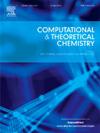Exploring the nitrogen migration mechanism during the pyrolysis of tyrosine and histidine based on density functional theory
IF 3
3区 化学
Q3 CHEMISTRY, PHYSICAL
引用次数: 0
Abstract
Proteins/amino acids are the main forms of nitrogen in biomass, and the formation mechanism of NOx precursors in their pyrolysis needs to be further studied. This work investigates the specific pathway of N element migration to pyrolysis gas and pyrolysis oil during the pyrolysis of tyrosine and histidine using density functional theory (DFT) calculation method for the first time. The results indicate that due to the lowest energy barrier and highest reaction rate of the NH3 formation pathway for direct removal of amino groups, the pyrolysis of tyrosine and histidine tends to generate NH3 rather than HCN. Nitrile and imidazole heterocycles are the main components of tyrosine and histidine pyrolysis oil, respectively. The former is obtained through continuous dehydrogenation reactions, while the latter is generated by the adsorption of active sites caused by the dehydrogenation of imidazole intermediates and hydrocarbon compounds, or the hydrogenation decomposition of nitrogen heterocycles themselves.

基于密度泛函理论探讨酪氨酸和组氨酸热解过程中氮的迁移机制
蛋白质/氨基酸是生物质中氮的主要形态,其热解过程中NOx前体的形成机理有待进一步研究。本文首次采用密度泛函数(DFT)计算方法研究了酪氨酸和组氨酸热解过程中N元素向热解气和热解油迁移的具体途径。结果表明,由于直接去除氨基的NH3生成途径具有最低的能垒和最高的反应速率,酪氨酸和组氨酸的热解倾向于生成NH3而不是HCN。丁腈杂环和咪唑杂环分别是酪氨酸和组氨酸裂解油的主要成分。前者是通过连续脱氢反应得到的,而后者是由咪唑中间体和烃类化合物脱氢引起的活性位点吸附或氮杂环本身的加氢分解产生的。
本文章由计算机程序翻译,如有差异,请以英文原文为准。
求助全文
约1分钟内获得全文
求助全文
来源期刊

Computational and Theoretical Chemistry
CHEMISTRY, PHYSICAL-
CiteScore
4.20
自引率
10.70%
发文量
331
审稿时长
31 days
期刊介绍:
Computational and Theoretical Chemistry publishes high quality, original reports of significance in computational and theoretical chemistry including those that deal with problems of structure, properties, energetics, weak interactions, reaction mechanisms, catalysis, and reaction rates involving atoms, molecules, clusters, surfaces, and bulk matter.
 求助内容:
求助内容: 应助结果提醒方式:
应助结果提醒方式:


